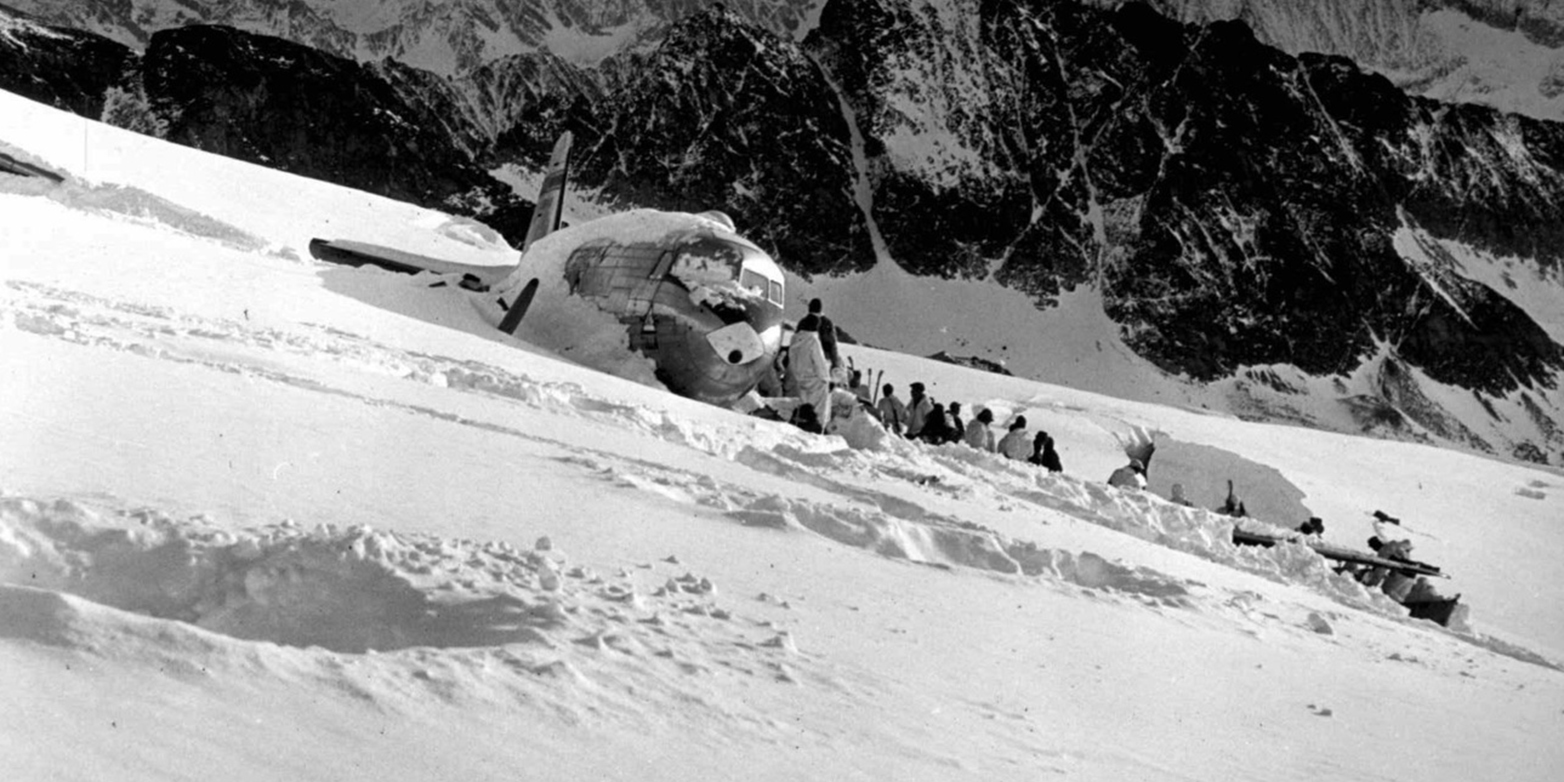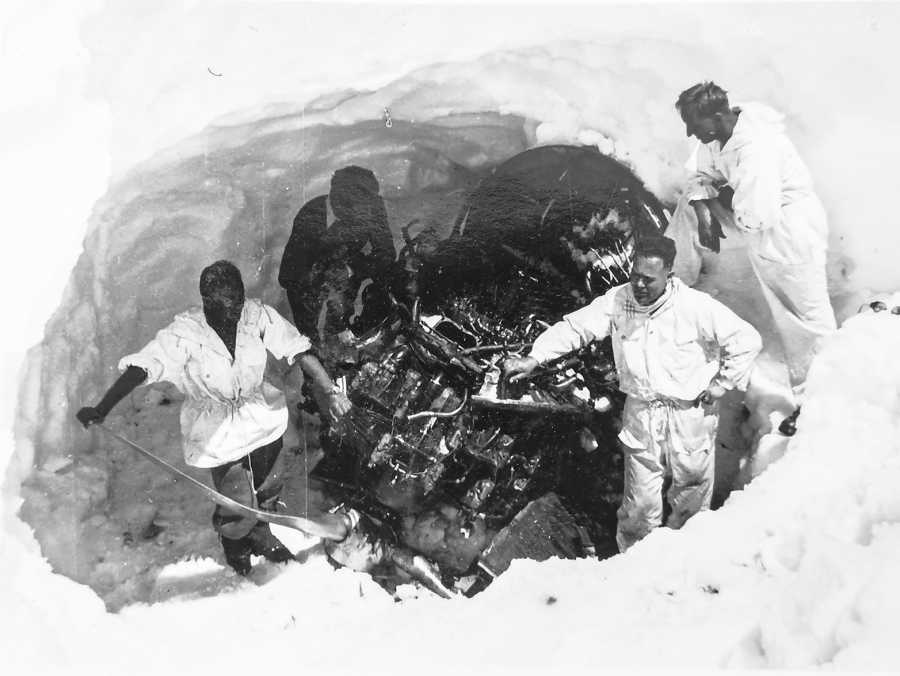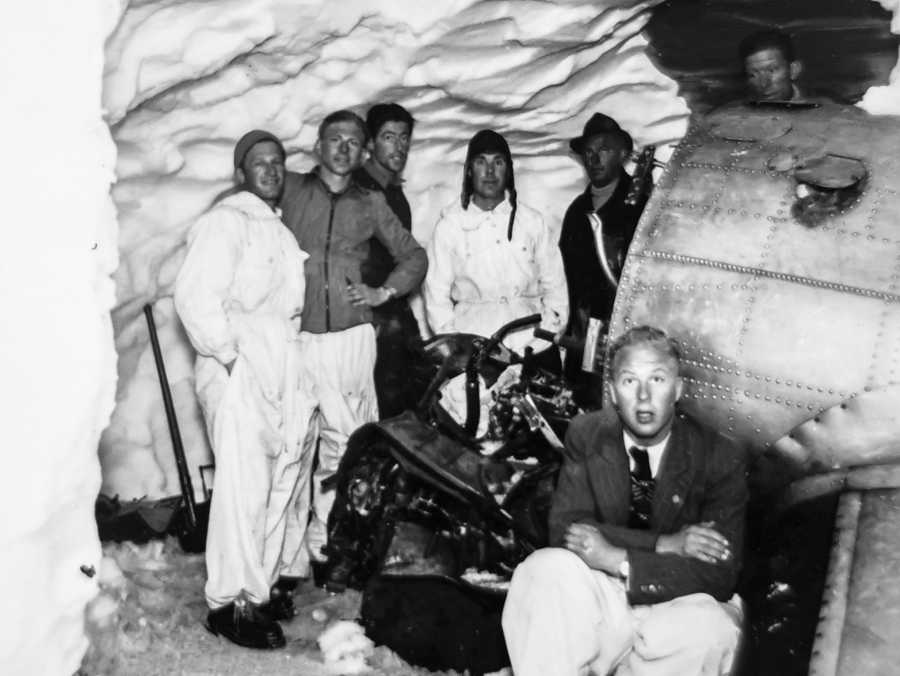During the last few years, some of the wreckage of a US Air Force plane that crashed on the Gauli Glacier in 1946 has been salvaged. Model calculations carried out by ETH researchers have now shown that it will probably take another 8 to 16 years for the aircraft’s fuselage to resurface from the ice.

In November 1946, a US Air Force plane was forced to perform a veritable crash landing on the Gauli Glacier in the Bernese Alps. While en route from Munich to Marseilles in dense fog, the pilot of the Douglas Dakota flew too low and collided with the terrain. With the plane remaining more or less intact, the passengers and crew all survived the crash and were rescued a few days later.
Wreckage for research
Afterwards, the president of the Swiss Glacier Commission, Paul Louis Mercanton, managed to persuade the Americans not to retrieve the crashed aircraft. Mercanton reasoned that the plane would be covered by snow and gradually sink into the ice. At some point it would then reappear, providing valuable insight into the movement of glacial ice.
Although the Swiss Air Force recovered several parts of the crashed plane during an expedition in spring 1947, most of the wreckage was left at the crash site, as Mercanton requested, becoming fully submerged in the glacial ice.
Unknown variables in the calculated flow of ice
It was only in the last few years that the Gauli Glacier relinquished its hold on various parts of the wreckage. For example, in summer 2018, a complex salvage operation succeeded in recovering a propeller, an engine block and parts of the wings. This naturally raises the question of when the plane’s fuselage can be expected to resurface.

Now, in a new study in the journal Frontiers in Earth Science, researchers at ETH Zurich’s Laboratory of Hydraulics, Hydrology and Glaciology (VAW) are coming to the conclusion that this might well be some time yet. Based on model calculations of ice flow, they estimate that the rest of the aircraft will resurface on the glacier between 2027 and 2035 – not where the wreckage has been found so far, however, but approximately one kilometre higher up.
“It is unlikely that the fuselage will reappear where the other parts emerged. This would require a much faster ice flow than expected over the last few decades,” explains Loris Compagno, who carried out the model calculation for his Master’s thesis.
Traces of the salvage operation
The researchers have come up with a plausible explanation for the distance between the past and the predicted recovery sites. “Using our model, we reconstructed where the previously discovered parts may have been located in 1947,” says Guillaume Jouvet, a researcher at the VAW. “Our calculations reveal that they probably found their way into the glacier at the spot where the Army had set up a landing strip for the recovery planes.”
Perhaps the parts that have resurfaced so far were simply too heavy for the relatively small rescue aircraft deployed for the very first salvage operation of its kind. “The engine alone weighed half a tonne,” says Compagno, who discovered the salvage operation in the course of his historical research. “That is presumably why these parts were just dumped near the landing strip.”
The salvage of the Dakota
-

The Dakota was buried deep in the snow in spring 1947. Parts of the plane were salvaged in a complex operation. (Photograph: Swiss Alpine Museum) -

The rescue team in deep snow. (Photograph: Swiss Alpine Museum) -

In order to retrieve the wreckage of the Dakota, a landing strip was set up for the rescue aircraft one kilometre below the crash site. (Photograph: Swiss Alpine Museum)
Combining different data
The researchers based their calculations on a combination of data. Thanks to earlier observations, they knew approximately how massive the glacier was in the late 1940s. Taking climate data and terrain models into account, they were able to calculate how fast the glacier could have moved over the last decades. “Our calculations are consistent with current measurement data, which we use to record the speed of the ice flow,” says Compagno. “Of course, we have no way of knowing exactly how fast the glacier was actually moving 70 years ago.”
A model for high-profile cases
The glacier model has already been used successfully to solve a mysterious case. Following the discovery of body parts belonging to three brothers who perished on the Aletsch Glacier in the 1920s, the ETH researchers were able to demonstrate with their model that the alpinists had apparently lost their bearings while returning to their hut on that fatal day. “At the time, we used our model to reconstruct a past event,” Jouvet says. “Now we are applying it as a forecasting tool.”
As a researcher, he is on tenterhooks to find out whether their predictions about the reappearance of the Dakota will prove correct. Should the plane’s fuselage re-emerge from the ice earlier than anticipated, Compagno and Jouvet would not be disappointed. Quite the opposite, for as Jouvet points out: “This important information would enable us to improve our description of the ice flow.” For example, assuming the fuselage resurfaces in the area where the first wreckage was found, this would indicate that in the 1950s, the Gauli Glacier must have been moving a great deal faster than expected. “That would be an extremely valuable finding for glacier research,” Jouvet says. Either way, there is no doubt in his mind that Mercanton’s initiative has already paid dividends for glacier research.


Reference
Compagno L et. al.: Modelling the Re-appearance of a Crashed Airplane on Gauligletscher, Switzerland. Front. Earth Sci. 2019. DOI: external page 10.3389/feart.2019.00170
Comments
No comments yet